With East West Rail set to re-establish the entire line between Oxford, Bicester, Bletchley/Milton Keynes, Bedford and Cambridge by 2030, this book looks at the history of the route, its operations, the campaign to reopen it again, and some of the benefits and downsides of the project.
Published in November 2023 by Amberley Publishing and written by K.C. Close and R.J. Cook, this soft cover book measures around 16.5 cm x 23.4 cm, has 96 pages and 100 illustrations.
It has a published price of £15.99, but at the time of writing, it can be purchased for £14.39 from Amberley Publishing and for £12.29 from Amazon.
The book is co-authored by K. C. Close who is a modern history graduate and has written a number of books about the area covered by the line, and R. J. Cook who has written books and articles on Aylesbury and Buckingham and was involved in a campaign to reopen the line in the 1980s.
Following an Introduction, eight chapters tell the story of the demise of the original line from Oxford to Cambridge, the campaign to reopen it, and the construction of the soon-to-be-reopened line as East West Rail.
Chapter 1 “The Campaign” tells how the original line’s closure was driven by politics as much as a reasoned business case. Residents became effective campaigners in assembling compelling evidence for the line’s reopening, which ironically was given added impetus when it was realised that parts of it would be ideal for transporting materials for the construction of HS2.
“The Buckinghamshire Railway Company“ in Chapter 2 describes the reasons for the original line’s western section from Oxford to Bletchley, while “Going East“ in Chapter 3 continues the story of its continuation to Cambridge.
“Working Order“ in Chapter 4 explains some of the problems the line’s operator had to overcome as it crossed the Great Central, West Coast, Midland, and East Coast mainlines on its journey from Oxford to Cambridge, whilst at Oxford it had to contend with meeting Brunel’s Broad Gauge.
Chapter 5 “Decline“ explores the short-lived hope for the line’s revival with the construction of the Bletchley flyover, then in Chapter 6 “Railway Lives – The Road To Paradise“ there are some interesting anecdotes from people who worked or remembered the line.
“Revival“ in Chapter 7 shows how the development of Milton Keynes, which was just a small village when the original line closed, helped to build a case for the line’s reopening, whilst “Clear Lines“ in Chapter 8 describes how Chiltern Railways’ reopening of the Bicester to Oxford line gave the impetus needed to put forward a business case for reopening the complete line.
The town of Winslow in Buckinghamshire, about one-third of the way between Oxford and Cambridge, features prominently with anecdotes about the station when it was operational, and as a focus for reopening the line, with some campaigners seen in the photo below left.
Over 20 years after the line closed, Winslow’s station even appeared as a backdrop for a photo shoot in 1990 as seen on the right below.
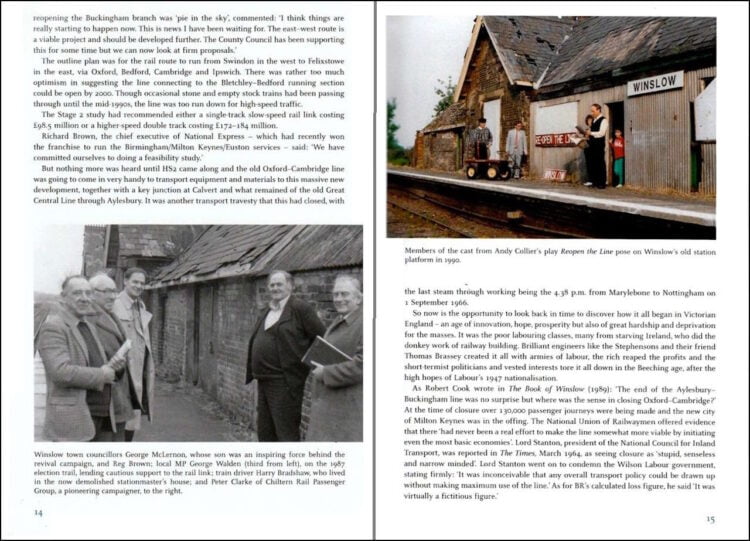
Photographs of Verney Junction such as those below give the impression of an important station that would never be closed.
Of course, it did, but given the benefit of hindsight, it seems strange why such a large station should be built in an isolated hamlet until you find that one of the line’s original backers was Sir Harry Verney who lived nearby and who gave his name to the station.
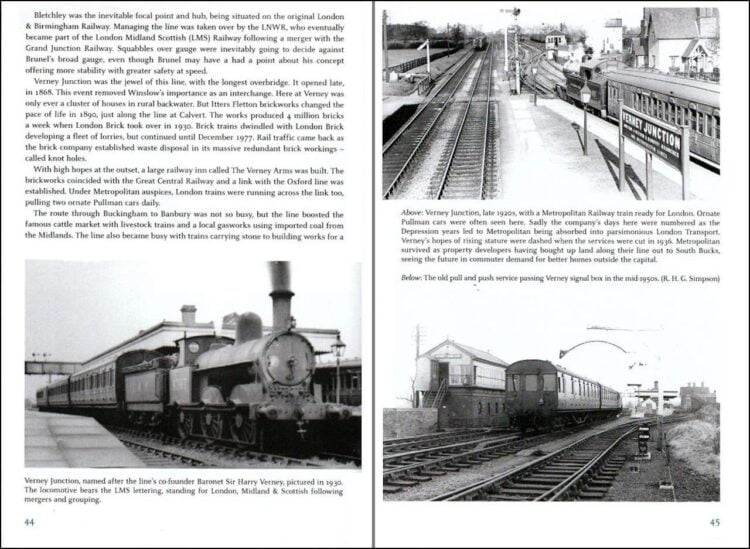
Looking rather better than the dilapidated state of Winslow Station in a previous photograph is the station in the images seen below. Like many stations on the line, Winslow Station buildings give the impression of a well-used artery.
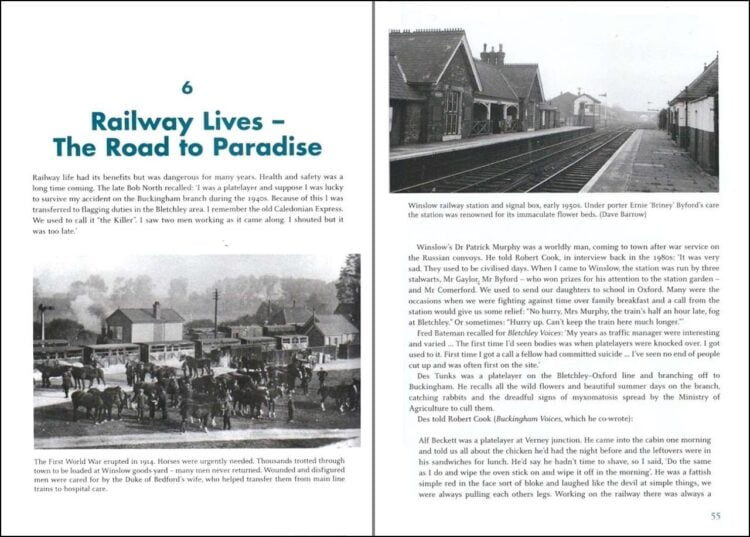
Unlike the line’s original builders, the construction of East West Rail has to take into account many unheard-of hurdles, one of which is a possible disturbance of bats. Illustrating one of the additional expenses incurred by 21st-century railway builders is the need to make provision for them, which was done at the former station of Swanbourne where the roof of the old booking hall was full of them, so the building shown on the left below was built to protect them. In the 1930s the LMS was experimenting with railcars, and one of their early attempts seen at the top right was trialled between Oxford and Bletchley.
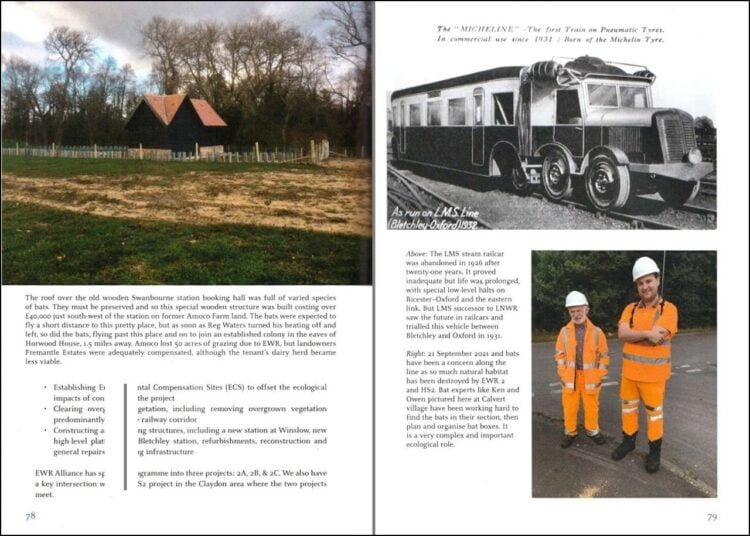
Construction of the new line is now in full swing, but there is no doubt that the new station buildings will lack many of the comforts and reassurance of the originals. At the top left is the construction site at Winslow, where one can only conjecture how the new station will compare with the one seen previously.
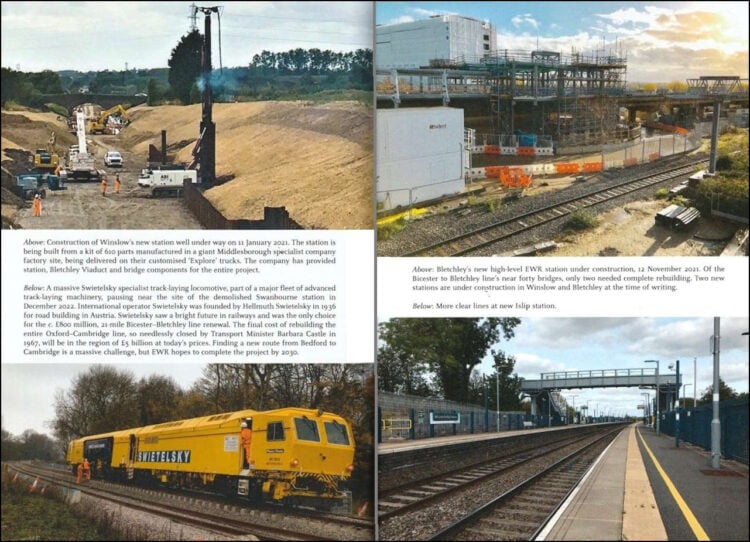
This is a well-written and lively book, full of human interest and personal tales telling the history of the Oxford to Cambridge line.
It explains the reasoning behind the building of the line in the first place, the political manoeuvrings behind its closure, and the campaign for its reinstatement.
Although there are plenty of anecdotes about the original line, there are very few operational details. The book purports to tell the story of East West Rail, but the final chapter is the only one that covers the new line, has few details about the line’s construction, and has no route map.
The authors obviously have a love for the line, but the book is very light on technical details such as a list of stations, the types of locomotives, and frequency of services.
There is a route map of the original line, but only covers four miles from where it passed under the Great Central to Winslow. Neither is there a route map of the new East West Rail.
The book is available to purchase from Amazon and from Amberley Publishing.
We would like to thank Amberley Publishing for providing us with a copy of the book for review.





Responses
Loverly to see pictures of my father and Grandad who was one of the signalman at Winslow